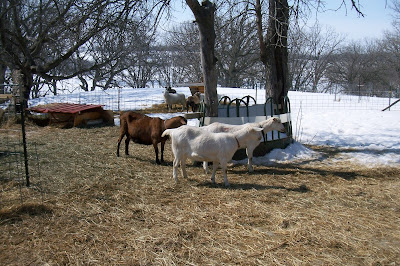This week there were no Friday classes at M-State so we had a make-up Farm Marketing and Management Class on Thursday before our Livestock class. We covered more of "Whole Farm Planning". We went over
profitability measures: Break Even Analysis
, to determine Break Even Volume and Break Even Value. Break even volume is basically how much you have to produce and sell to cover all your costs and overhead expenses. Where-as break even value is what price do you have to place on your product just to break even. there was additional discussion on enterprise budget as part of your income statement.
 |
| Is that snow ever going to melt? |
We then covered Contingency Planning which is a plan for what you are going to do when things do not work out as you anticipated they would.
In livestock class we started with the most important "Nutrient" on the farm WATER! Discussion included how much water various animals need each day, providing access to water, redundant water sources (especially for dairy), and various water sources (pressured from well, hauling water, sand point, surface water sources, windmills, solar pumps) and the importance of using gravity whenever you can. There was also discussion on winter water sources.
The next part of class was spent on "Silvopasture" which is the integration of trees with livestock production and timber production. We then went over livestock feed consumption rates, outside of grazing, for various types of animals from hogs to turkeys. We then went into common crop production yields/acre/year so you can estimate how many acres you have to plant to meet the feed rates previously discussed. Class finished up with the beginning of the section on "Management of Individual Species on Pasture. Last but not least we got our take home final for the class. This assignment required us to develop a management for a hypothetical farm consisting of 25-acres of owned crop land, 20-acres of a thin stand of alfalfa/smooth brome hay ground, 50-acres of KY bluegrass pasture (currently continuously grazed) and a 50-acre red pine plantation. there was an additional adjacent 75-acres of rented property that consists of 45-acres of crop land and 30-acres of KY bluegrass / orchard grass pasture.

Since classes were canceled on Friday we had the opportunity to attend a bonus Horse Clinic workshop at Paradox Farm. The workshop started with a discussion on determining if a horse fits into your farms future and included horse needs for fencing, feed, health, horse selection, training and safety requirements. The workshop also included some hands on work with horses.
 |
| Hoof Maintenance and Handling |
 |
| Lunging |
 |
| Checking and cleaning the front hoof with a pick |






No comments:
Post a Comment